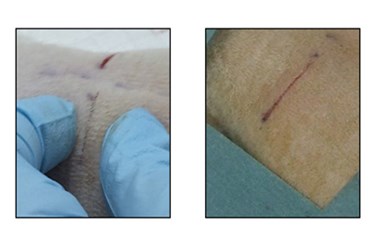Nanoparticle "Glue" Helps Repair Tissue
By Joel Lindsey

A team of researchers in France has developed a nanoparticle adhesive liquid that they say could revolutionize the clinical treatment of wounds and damaged organs.
The team used a substance comprised primarily of silica and iron oxide nanoparticles in experiments aimed at testing how effectively lacerations in various types of tissue could be “glued” shut.
In the first experiment, researchers used two different methods for skin closure in deep wounds located on the bodies of rats: traditional sutures and the newly developed aqueous nanoparticle solution. The wounds treated with the nanoparticle solution healed quickly and with minimal residual scarring.
The second experiment, which was also performed on rats, focused on trying to close cuts or wounds on internal organs. When applied to deep cuts in the liver that were causing significant bleeding, the nanoparticle solution quickly and effectively closed the lacerations, according to a press release from the French Institute of Health and Medical Research.
“The principle is simple: nanoparticles contained in a solution spread out on surfaces to be glued bind to the [tissue’s] molecular network,” according to the press release. “At the same time the [tissue] binds the particles tighter. Accordingly, myriad connections form between the two surfaces. This adhesion process, which involves no chemical reaction, only takes a few seconds.”
Researchers have pointed out that in addition to being able to quickly and effectively close cuts, the nanoparticle solution can also be used for a variety of internal medical treatments. Because the liquid can be metabolized by the body, it may be used as an adhesive inside patients’ bodies.
“‘Gluing a film to stop leakage’ is only one example of the possibilities opened up by adhesion brought on by nanoparticles,” according to the press release. “The researchers have succeeded in using nanoparticles to attach a biodegradable membrane used for cardiac cell therapy, and to achieve this despite the substantial mechanical constraints due to its beating.”
“They thus showed that it would be possible to attach various medical devices to organs and tissues for therapeutic, repair or mechanical strengthening purposes.”
Results from these experiments are described in an article published by the journal Angewandte Chemie.
Researchers involved with the project ultimately see their nanoparticle solution as part of an ongoing project of working to improve tissue regeneration.
The broad field of tissue regeneration has received significant media attention lately. Last week, for example, Med Device Online published an article about new techniques being developed to improve the regeneration and laboratory growth of a variety of human tissue and organs, including the thymus, the nose, and genital tissue.
Image Credit: © “Matière Molle et Chimie” Laboratory
